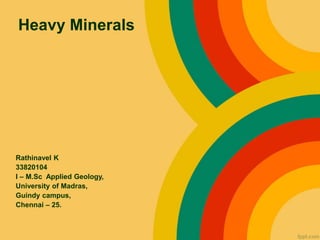
Heavy minerals
- 1. Heavy Minerals Rathinavel K 33820104 I – M.Sc Applied Geology, University of Madras, Guindy campus, Chennai – 25.
- 2. Placer deposits Placer minerals are important economic mineral deposits with high specific gravity and formed by the process of mechanical concentration due to weathering, transportation and deposition in suitable location. These deposits are known as Placer Deposits and minerals that accumulated in the deposits are called as Placer Minerals. The placer minerals are formed by natural gravity separations. These placer deposits consists mostly in heavy minerals. Placer materials must be both dense and resistant to weathering processes.
- 3. To accumulate in placers, mineral particles must be significantly denser than quartz (whose specific gravity is 2.65), as quartz is usually the largest component of sand or gravel. Placer environments typically contain black sand, a conspicuous shiny black mixture of iron oxides, mostly magnetite with variable amounts of ilmenite and hematite. Valuable mineral components often occurring with black sands are monazite, rutile, zircon, chromite, wolframite, and cassiterite.
- 4. Heavy minerals are minerals with a density greater than 2.8…2.9 g/cm3. Heavy minerals are of great value in studying the provenance, transportation and weathering history of the sediments and in correlation purposes. They include economically important minerals rich in titanium, zirconium and rare earths. most of heavy minerals are in dark and bright colour. Which is easy to identify. Heavy Minerals
- 6. Heavy minerals are classified into types for the convenience of density of the useable. i). Heavy heavy minerals with a density of 6.8 – 21 g/cm3. ( mainly gold, platinum, cassiterite). ii). The light heavy minerals with a density of 4.2 – 6.7 g/cm3. ( mainly ilemenite, rutile, zircon, monazite, magnetite, chromite) iii). Gemstones with a density of 2.9 – 4.1 g/cm3. ( mainly gold).
- 7. Seperation Methods The heavy mineral deposits are beneficiated through a combination of unit operations such as gravity concentration, magnetic separation, and electrostatic separation techniques. All these physical separation processes exploit the difference in specific gravity, electrostatic, and magnetic properties of heavy mineral species . Low-intensity magnetic separation is used to remove ferromagnetic minerals such as ilmenite and high- intensity magnetic separation is used to separate minerals like monazite from other heavies.
- 8. Magnetic separation is initially done to recover the Fe-bearing magnetic minerals like ilmenite, followed by electrostatic separation for recovering the conductors such as rutile from the nonconductors such as zircon, quartz, and monazite. Due to the relatively high specific gravity, gravity separation can be used to concentrate heavy minerals by eliminating low specific gravity gangue minerals such as quartz and other light minerals,
- 9. Representative raw placer samples of 20 kg each collected up to a depth of about 1 m from A and B coastal stretches were processed to separate and estimate heavy minerals from the bulk beach sand. The raw sand samples were subjected to a series of mineral separation techniques which include magnetic, electrostatic, and gravity methods..
- 10. Magnetic separation is used to separate minerals with different magnetic properties. It separates magnetic minerals from those of nonmagnetic or less magnetic nature. Minerals are classified as ferromagnetic, paramagnetic, and diamagnetic based on their magnetic properties. Ferromagnetic and paramagnetic mineral particles will both be attracted, whereas a diamagnetic mineral particle will be repelled by a magnetic field. The applications of high-intensity dry magnetic separators are well accepted to selectively separate paramagnetic minerals such as ilmenite. Magnetic separation
- 12. Electrostatic separation is used to separate minerals with different electrical properties. It separates conducting minerals from those of nonconducting or less conducting nature. When the minerals are passed through an intense electrical field, each particle acquires a charge depending upon their composition and becomes separated into conducting and nonconducting. When a high potential difference is applied, titanium-bearing minerals like ilmenite, rutile, and leucoxene behave as conducting, whereas garnet, monazite, sillimanite, and zircon behave as nonconducting material. Electrostatic separation
- 13. Gravity separation methods such as centrifugal separation using spiral concentrators are used to separate the heavy minerals based on the differences in their specific gravity . Short spiral concentrator is used for the separation of garnet, rutile, ilmenite, zircon, and other heavies from low-density minerals such as quartz, clay Gravity separation
- 15. These minerals occur in very low concentrations in a variety of igneous and metamorphic rocks, but being chemically and physically resistant to weathering, and having comparatively high specific gravity, they tend to accumulate in placer deposits in river channels or along coastal shoreline Beach sands contain the most important accumulations of these minerals; wave action deposits sand on the beach, and the heavy minerals are concentrated when backwash carries some of the lighter minerals such as quartz back into the sea. Onshore winds which preferentially blow lighter grains inland can lead to higher concentrations of heavy minerals at the front of coastal dune Occurrence
- 16. Heavy minerals are often used as indicators of sediment provenance and flow dynamics in various types of sediments, including in tsunami deposits. Heavy minerals described in tsunami deposits are likely concentrated in pockets or laminae, but their distribution within the deposits sometimes shows no vertical trend Heavy minerals such as iron oxides (ilmenite, magnetite), diamonds, and some silicates (zircon, garnet, and olivine) are characterized by high coefficients of X-ray attenuation, and they are easily distinguished from other minerals on X- ray imagery. Distribution of heavy minerals